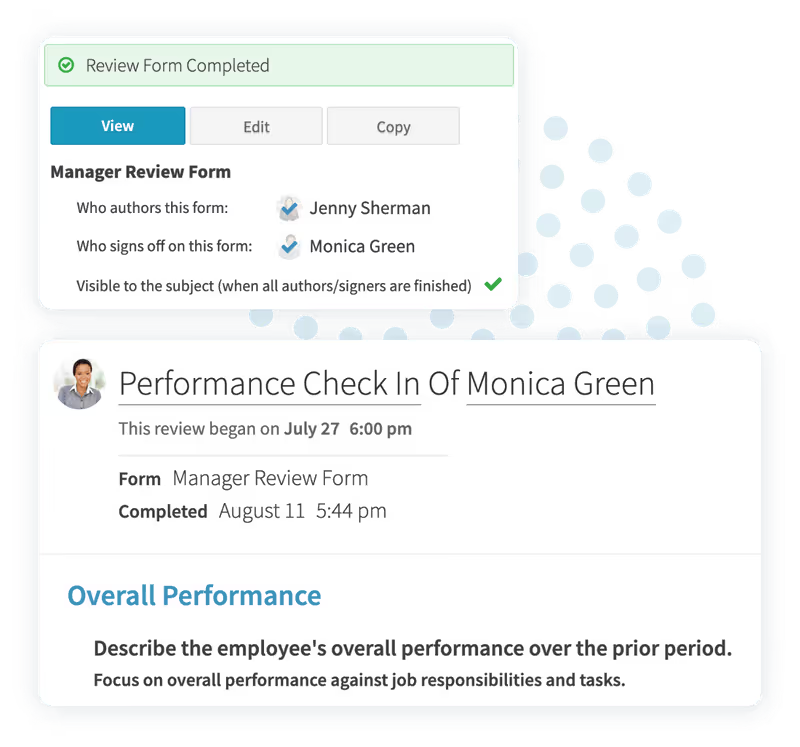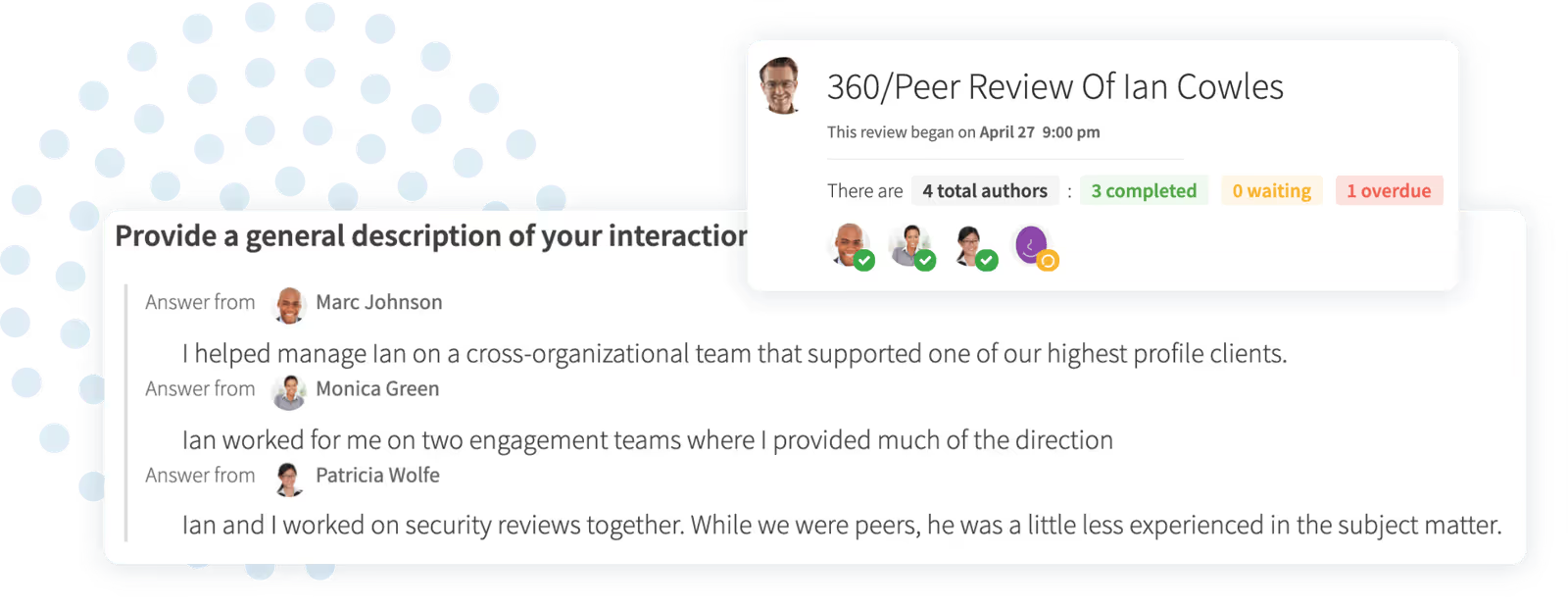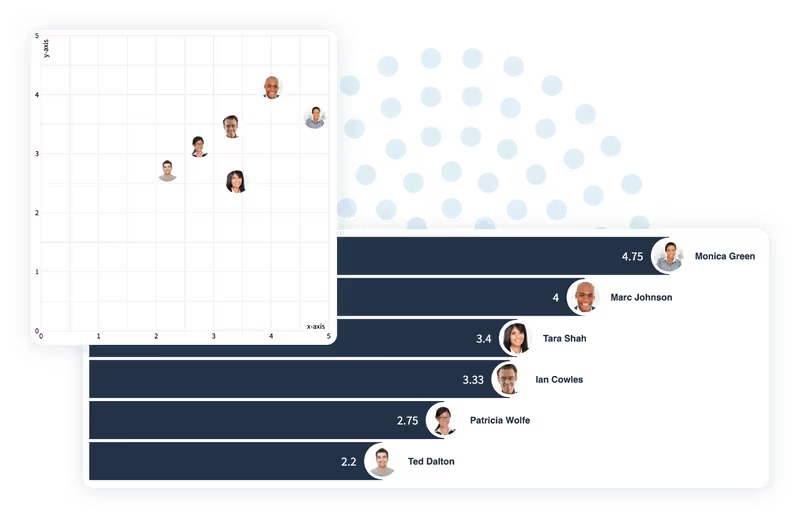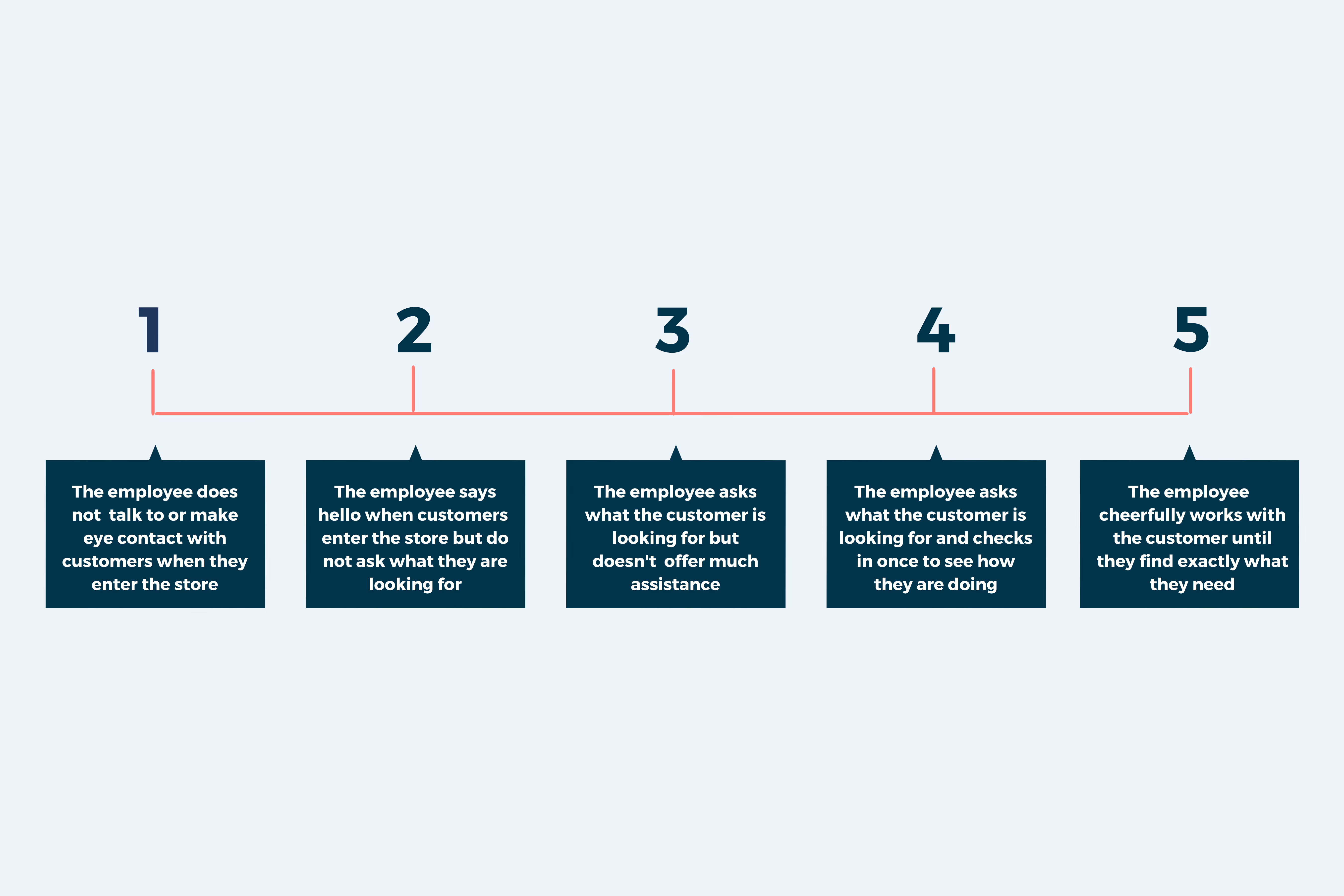15 Types of Performance Appraisals
There's nothing more fundamental to the success of an organization than employee performance. Maybe that’s why there’s a seemingly endless number of performance appraisal processes for evaluating, measuring, driving, and developing employee performance.
Because there are so many options, choosing the right performance appraisal approach for your organization can be daunting.
What are the types of performance appraisal?
The PerformYard software platform has helped thousands of organizations run hundreds of performance management processes. In this article, we'll review 14 of the most common performance evaluation methods ranging from traditional methods of appraisals like competency assessments to more extreme appraisal techniques like human resource accounting. We’ll also share when it is most effective and appropriate to use each approach.
When building out a complete performance management system, organizations will often choose to combine a few of the following appraisals. Be sure to think about what outcomes are most important to your organization when considering the following examples.
1. Check-Ins
Performance check-ins are often confused with other types of performance reviews, but they’re not exactly the same thing. Performance check-ins happen more often, they are more informal, and they give managers the opportunity to build rapport and find out what employees are working on between cycles.
Check-ins can have set agendas or be completely open-ended. Most often, employees and managers will discuss progress towards company goals, overall performance since the last check-in, and the employee’s aspirations.
The primary role of check-ins is to create a consistent time and space for discussions about long-term performance. Managers should consistently take notes after check-ins throughout the year. Then when employee reviews come around, managers can use notes from check-ins to evaluate the employee’s performance and guide the conversation.
Documenting the check-in is vital to the success of the performance review. PerformYard's software can remind you about check-ins and store the goal updates and discussion points. The image below shows how check-in data is stored in PerformYard where it can be referenced in quarterly or annual reviews.

When to Use Check-Ins
Check-ins are less complex than many types of performance appraisals, but more frequent. They usually take place between more intensive appraisal processes to spread out performance discussions throughout the year without overburdening employees and the organization.
2. 360 Feedback
360 feedback involves getting broad feedback from an employee’s coworkers. This can mean peer reviews, self-reviews, manager-reviews, secondary manager reviews, or upward reviews. PerformYard gathers 360 review responses and stores them in the employee's review dashboard for easy access, as seen in the image below.

The idea is to increase the sources of feedback in order to get a more accurate and holistic view of employee performance. 360 feedback will often be open-ended or thematic with the employee’s manager reviewing and aggregating the feedback into a single more cohesive picture of performance.
When to Use 360 Feedback
360 feedback is a great option for when employees regularly work collaboratively on different teams.
When an employee’s primary role is working with others outside the view of their manager, 360 reviews can bring up feedback that might not otherwise be raised. Peers are often hesitant to give negative feedback outside of a formal context, but 360 reviews provide that context.
360 reviews can be a great source of feedback, but they also require a lot of coordination. The administration of 360 feedback can be a burden on both managers and employees, so it’s important to have a process in place for every stage of the 360 process.
Another key to successful 360 reviews is to train everybody in the organization to deliver effective feedback. When employees don’t have experience giving feedback, what they share may be more destructive than constructive. Giving effective feedback is a skill that needs to be developed and practiced.
3. Narrative Appraisals or Essay Appraisals
As its name suggests, the narrative performance appraisal (or essay appraisal) is created when a manager writes a freeform essay about an employee’s performance over a specific review period.
Essay appraisals allow reviewers to discuss anything they feel is pertinent to the employee without being locked into certain questions.
In a perfect world, this approach would allow managers to focus on exactly what an employee needs to hear and provide the most relevant feedback. But in reality, managers don’t always express themselves clearly. Essay appraisals can leave employees feeling confused on where they stand.
The narrative appraisal is also customized to each employee, which makes it nearly impossible to make comparisons across employees. Essay appraisals are often paired with another appraisal method, such as graphic scale rating, to draw more accurate conclusions.
When to Use Narrative or Essay Appraisals
Essay appraisals are best for employees with loosely defined jobs or who do very individualized creative work. If it's hard to quantify the inputs and outputs of employees’ work or you feel like every employee would need their own custom appraisal questions in order to get relevant feedback, the narrative appraisal could be right for you.
But a word of caution: essay appraisals can quickly get off the rails and become unnecessarily complex. Setting a standard for the style and length of essay appraisals can help keep reviewers on track.
4. Competency Assessment
Competency assessments measure an employee’s capabilities against their critical job skills. These assessments show the gaps between where an employee needs to be and where they are now.
Competency assessments often flow naturally into a concrete learning plan focused on the competencies with gaps.
This type of appraisal can be conducted in a variety of ways: through observation, interviews, or forms. The key is to choose the right competencies for every role at your organization.
When to Use Competency Assessments
Competency assessments are great for jobs where success is dependent on well-understood skills. It usually helps to have many employees in a similar role so that you can begin to understand the competencies that matter through experience.
Focusing on a specific set of competencies can lead you down the road of only recognizing employees who succeed in one specific type of way. Employees who drive great outcomes but do so in unexpected ways may find it difficult to progress when they are evaluated on competencies, rather than outcomes.
To combat this issue, Western National Insurance Group paired competency assessments with open-ended questions, such as:
- What is the employee doing well?
- What are some of their notable accomplishments?
- What do they still need to work on?
- What stretch goals are they working on to improve?
They then track responses to both competency assessments and open-ended questions using performance management software.
5. Project-Based Reviews
Project-based reviews are unique in that they focus on the most recent work an employee has completed. These reviews include questions that are directly related to an employee’s contribution to a project.
Feedback cycles can be quicker with project-based reviews, as projects often cycle more frequently than traditional review cycles. Because of the frequency, it’s important to have a system that helps project-based reviews run smoothly.
When project-based reviews are used, employees have the opportunity to receive and internalize feedback before getting into the next project where they can then demonstrate any improvements.
When to Use Project-Based Reviews
Project-based reviews are best for companies that work on distinct projects one at a time (or almost one at a time). These reviews work best when these projects last from a few weeks to a few months. Typical examples are accounting audit teams, consulting teams, and some types of law firms.
Project-based reviews are especially useful when organizations are bringing together new groups of employees for each project.
6. Stack Ranking Appraisals
Stack rankings and forced distributions are a controversial method of performance appraisals that rely on ranking employees against each other.
Sometimes this is a top to bottom list, and sometimes it’s sorting employees into buckets of high-performing, low-performing, and the middle with quotas for each.
Rankings force managers to differentiate between employees to find out which ones actually have the highest performance. It also makes it very clear where employees stand in relation to their peers.
When used in combination with continuous feedback and tracked in a system like PerformYard, stack rankings can be a powerful tool to create a more productive workforce overall.
When to Use Ranking Appraisals
Ranking appraisals can work great for competitive environments like up-or-out consulting firms. In these situations, everybody knows they need to be a top performer to stay with the firm, so it’s healthier to make this process transparent and open.
Forced distributions can also be a useful approach in the short-term for organizations that have become stagnant and are being dragged down by low performers. Sometimes letting employees who have checked-out move on to a new job and bringing in fresh talent is the best decision for everybody involved.
Rankings are not great for companies that are focused on innovation or creativity, as moments of creativity can be uneven and unpredictable. Pushing employees out after one underperforming year probably doesn’t make sense in that context.
Stack ratings also aren’t great for organizations that need to be extremely collaborative, as they create tension and competitiveness between employees.
7. Grading/Rating Appraisals
In a grading/rating performance appraisal, managers use a numerical (1-5) or descriptive scale to record an employee’s performance in specific areas of their job.
Because they are easy to fill out and create quantitative data, rating appraisals are very popular.
One of the keys to rating appraisals is making sure managers aren’t just doing the minimum amount of work necessary to get them done without having the difficult and important conversations needed to accompany these types of appraisals.
Ratings send a very clear message of where an employee stands, but do a very poor job of telling an employee where they need to go. Companies may choose to combine ratings with qualitative comments and feedback to give employees a clear understanding of why they received the ratings they did. Ratings can be useful for seeing how employees stack up against each other. PerformYard's reporting software can show ratings with clear visuals, as in the below example.

When to Use Grading/Rating Appraisals
Rating scales work well at organizations that need to create more accountability because it’s impossible to spin a low rating.
Ratings feedback is quantitative, but organizations can struggle to stay organized and manage the data. It’s important to have a system to manage all of the feedback received from rating appraisals so you can make full use of this approach.
If you’re wondering whether or not you should implement rating appraisals, remember that you'll need to do more than just tell employees they’re underperforming if you want them to step up their game. Analyzing performance data and helping employees understand where they can improve is key.
8. Behaviorally Anchored Rating Scales (BARS)
Behaviorally Anchored Rating Scales (also known as BARS) uses behavior “statements” as a reference point for rankings. BARS measures employee performance against specific examples of behavior that are given a number ranking. See below for performance appraisal examples from the BARS system.

For example, a pizza place could use a Level 1 ranking to describe an employee who takes more than 10 minutes to make a pizza, while a Level 5 ranking would describe an employee who makes a pizza in under 5 minutes.
BARS is helpful because it combines qualitative and quantitative assessments. The behavioral definitions can also aid in eliminating ranking bias.
When to Use BARS
Because BARS creates the ability to design a unique performance management experience for every position within an organization, it’s typically best for organizations that have groups of positions or departments made up of similar types of jobs.
BARS is also helpful for companies that struggle with bias challenges in their current performance management process. The emphasis on behavior produces objective ratings that are difficult to distort.
One of the biggest challenges of BARS is being able to articulate exactly what great performance looks like in advance. Using BARS may mean that you have people who live up to your expectations, but not people who surprise you and surpass your expectations in new ways.
9. External/Client Appraisals
External and client appraisals involve bringing in third parties from outside the company to help with performance reviews.
For employees that primarily engage with customers or clients, this can be the most important source of feedback.
When to Use External/Client Appraisals
Client appraisals are great for service roles where an employee's primary job is to interact with customers. Gig-economy companies like Uber rely exclusively on client appraisals to manage their contract workforce.
External appraisals are also a good option for employees that work as closely with a client as they do with their coworker, like a consultant on site with a client for an extended period.
Keeping track of the process is one of the most challenging aspects of client appraisals. Managers and HR professionals have enough on their plate without emailing questions, sending reminders, and following up with clients to keep the process moving.
If you’re considering client appraisals, make sure you have a process in place to keep track of all of the moving parts.
10. Management by Objectives (MBO)
Management by objectives (MBO) measure employee performance by how employees achieve specific objectives. These objectives are decided on with equal input from employees and managers.
Effective objectives should align with organizational goals. Managers and employees should equally participate and communicate to ensure the objectives are met.
When to Use MBO
MBO can be an effective method for many organizations. This method isn’t difficult to implement and can truly suit the needs of most organizations without incurring major costs.
The most difficult part of MBO is the communication required.
To set and achieve successful goals, a substantial amount of input and feedback is needed from both managers and employees.
It’s helpful to have all of this feedback stored in one place for both parties to refer back to. This helps managers and employees easily track progress and see what’s needed to meet the objectives.
11. Checklist Appraisals
In checklist appraisals, managers are asked to answer “yes” or “no” to a series of questions or statements about an employee. These appraisals tend to be easy to complete and can help an employee know where they stand across a broad set of domains.
Google famously uses this approach to review their managers. Employees answer yes or no for a long list of actions Google believes good managers should be taking with their reports.
When to Use Checklist Appraisals
Because checklist appraisals are binary, they’re best used for traits where levels of gray are less important. Checklists are also great when you need to provide a lot of feedback in many areas but need to keep the appraisal easy to complete.
A major con of checklist appraisals is that they don’t allow for explanations or detailed answers. This method is most effective when combined with a more detailed method, such as narrative appraisals.
12. Critical Incident Appraisals
For critical incident appraisals, managers keep a log of specific examples of both negative and positive behavior exhibited by employees. The standard for behavior can be based on company values or an employee’s job description.
After a period of time, managers and employees meet to discuss the log and evaluate performance. A continuous log makes sure that performance reviews focus equally on performance across the year and concrete moments, rather than general sentiments.
When to Use Critical Incident Appraisals
Critical incident appraisals are simply descriptions of events and that can make it hard to compare employees or make decisions based on them.
They can also be overwhelming and hard to interpret. We recommend pairing critical incident appraisals with some sort of quantitative method.
13. Human Resource Accounting / Cost Accounting
Also called cost accounting, human resource accounting analyzes an employee’s performance through the monetary gains they bring to the organization vs. the cost to retain the employee.
When to Use Human Resource Accounting
Human resource accounting is most useful when employee contributions and costs are measurable. This can happen in situations where executives are judged on their P&L, or for positions like sales where the ultimate measure of success is revenue generated.
Unfortunately, it’s extremely difficult to perfectly understand all of the costs and benefits an employee has on an organization. Human resource accounting also doesn’t account for technology, which can greatly reduce the overall costs in an organization by automating processes that were previously done by employees.
14. Psychological Appraisals
Psychological appraisals are unique in that they consider an employee’s future performance, rather than focusing on their past.
In this appraisal, psychologists look at the employee’s internal traits and qualities that could affect their performance in the future.
The psychologists can look at specific scenarios when performing their appraisal to discover how an employee is likely to perform in similar scenarios in the future.
When to Use Psychological Appraisals
Psychological appraisals can help organizations see employees’ potential. They can be used in specific scenarios, such as determining which employees should be pushed toward leadership roles or managing reorganizations of the org chart.
While useful, psychological appraisals can be time-consuming and costly, especially for small organizations. They are also difficult for organizations to manually administer. There is also controversy over how well the psychological traits will actually predict future performance as people are not static.
15. OKRs
Objectives and key results (OKRs) are focused on quantifiable measures to evaluate performance, which are designed to assess the company and team's performance. The goals are the “what” of performance; the results are the “hows.” This style is popular with tech companies because it’s an excellent way to manage growth through executing common goals.
When to Use OKRs
OKRs keep planning focused on impact, so this metric is best utilized at the team level. This method works on the inverse of micromanaging because it’s an effective mechanism for aligning top-down strategy with bottom-up, team-level commitments to support the processes involved. OKRs de-emphasize specific tasks and emphasize value. OKRs work best as a team-based goal rather than a particular methodology due to a shared objective and quantifiable metrics, which helps a team coordinate activity, align with stakeholders, and move with more than just immediate goals as a finish line.
Choosing an Approach and Next Steps
Hopefully you’ve been inspired by one or more of the types of appraisals we’ve outlined above. Which ones you choose to implement will all depend on the needs of your own organization. We have a number of other articles that can help you determine which is the best fit and how to implement it:
- Choosing a Purpose for Performance Management
- Creating a Modern Performance Management Strategy
- How to Implement Performance Management
No matter what direction you take, it’s vitally important to get your process right. Most appraisals fail because employees resent how cumbersome and irrelevant they are. Choosing the right type of appraisal should make them more relevant, but you still need to make them more streamlined.
Look for ways to automate form assignments and generate real-time alerts for employees when they need to complete self or manager review forms.
Simplify the sign-off flows so everyone knows when a form is ready for sign-off and can easily send forms back for changes.
Track cycle progress so you can quickly intervene when managers are falling behind; even better, automate reminders.
The more you can rely on a well-designed system to run your review process, the less you’ll force your managers to deal with the administrative minutia they resent.
Once you’ve nailed the approach and the process, you’ll be well on your way to effective performance appraisals.
Frequently Asked Questions
What is the best form of performance appraisal?
The best performance appraisal is the one that serves your organization’s needs. If you’re just getting started, consider a narrative appraisal with a few simple rating questions that focus on overall performance.
What type of performance review provides the best feedback?
Checklist appraisals can provide a broad array of feedback quickly, however, for the best overall feedback, it’s hard to beat a well-written narrative review. Unfortunately, not all managers will take the time to write comprehensive and thoughtful narrative reviews.
What is the best way to evaluate employee performance?
If you’re looking to generate quantitative data on employee performance, consider using ratings appraisals that ask simple questions managers likely already have conviction around. Good questions include, “Is this employee ready for promotion?” and “How hard would you fight to keep this employee at our organization?”
What should I include in a performance evaluation?
One thing to include in every performance evaluation is space for context and ways for the employee to improve their performance going forward. It’s important that employees have enough information to understand their feedback and know what to do with it.
What is the most common performance appraisal method?
Formal check-ins, narrative appraisals, and competency assessments are the three most common appraisal methods used today.


.jpg)

.jpg)
